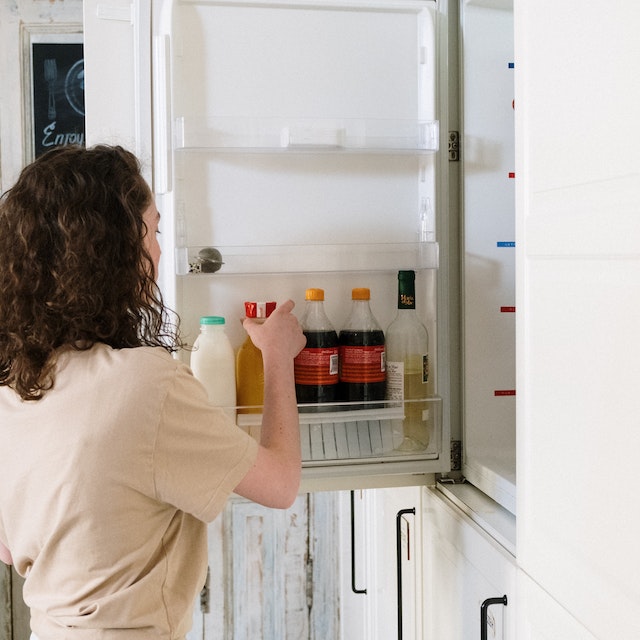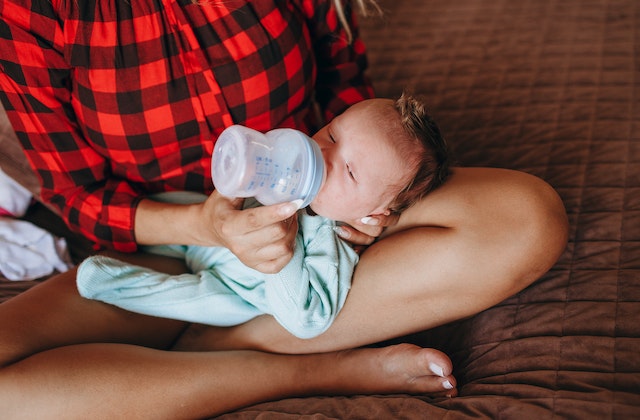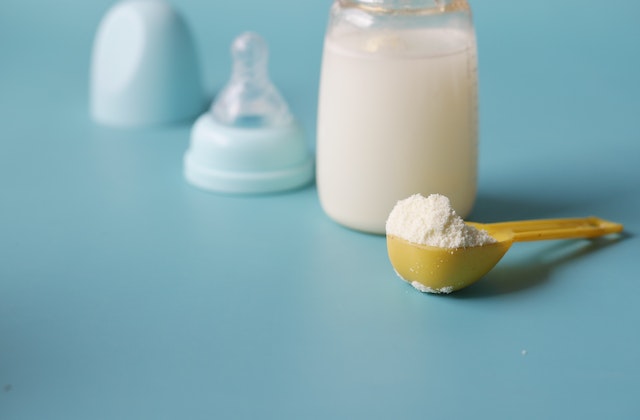
Are you contemplating is it safe to freeze formula? This post will guide you through everything you need to know about the safety of freezing baby formula.
While some parents find it convenient to freeze infant formula, the Centers for Disease Control and Prevention (CDC) does not recommend this practice due to potential health risks.
By following these tips, you can help reduce any potential health risks associated with freezing infant formula.
- Is It Safe To Freeze Formula?
- Methods For Safest Formula Freezing
- 1. Properly Wash Your Hands
- 2. Choose The Amount Of The Formula You Want To Freeze.
- 3. Go Through The Manufacturer's Instructions Provided With The Baby Formula.
- 4. Select A Secure, Sanitized Container
- 5. Employ The Quantity Of Scoops Suggested By The Manufacturer
- 6. Label The Container, Then Keep It In The Freezer.
- Is Powdered Formula Freezable?
- Other Items To Consider
- Is It Advisable To Freeze Homemade Baby Food?
- Other Safety Considerations When Making Formula
- In Conclusion
Is It Safe To Freeze Formula?

Freezing baby formula can be a practical option for some parents, but it’s important to do it safely. Before freezing, it’s important to be aware of potential risks and negative effects. While breast milk and infant formula can be frozen for several reasons, such as saving time on daily formula preparation and being more convenient to bring along while traveling, there are also warnings to take into account.
One major concern is the potential growth of harmful bacteria if the formula is not handled properly during the freezing and thawing process. The CDC does not recommend freezing infant formula because the process can destroy some of the nutrients and antibodies that help protect your baby’s immune system. Additionally, the texture and taste of the formula may be altered after it’s frozen and thawed.
After learning about some of the advantages of freezing baby formula, let’s move on to some of the baby formula warnings to take into account:
1. Separation between the fat and the remaining ingredients in a formula might occur when it is frozen.
Although the freezer is a great place to keep your food fresh, it could become spoiled. The formula’s fat can be separated from the remaining ingredients when kept in the freezer.
As a result of this separation, your infant may find the powdered formula mix less appetizing in terms of taste and texture.
2. Freezing baby formula could encourage bacterial growth
Your freezer’s excessive temperature may render newborn formula milk dangerous to consume if it has been exposed to bacteria before being frozen.
Additionally, even if the infant formula is frozen before its expiration date, it might not be safe for you to use if it is past the date.
3. Freezing baby formula can degrade nutrients
Reviewing your formula’s nutrition facts is a good practice at all times, and it’s crucial to understand that freezing might change them. Nutrients may be lost when newborn formula is frozen.
The nutritional value of food is typically little impacted by freezing. The nutrients may deteriorate, nevertheless, during pre-freezing procedures like blanching and the thawing of frozen infant formula.
As a result, when selecting whether or not to freeze your formula, you might think about the age and needs of your infant.
For instance, if you are feeding a baby who is solely dependent on the nutrition in the formula, you may decide to forego freezing to guarantee they get the nutrients they need.
A Popsicle made with formula can be a great option if you’re just looking to make a fun and wholesome treat for a toddler who is eating plenty of other healthy food, though!
Methods For Safest Formula Freezing

We acknowledge that freezing baby food carries some risks, but that it can also be a practical choice for parents and a waste-reduction tool. Let’s examine how you can reduce the risks to ensure the highest level of safety when making your baby’s formula.
1. Properly Wash Your Hands
We use our hands for almost everything, and they can accumulate a lot of bacteria throughout the day. To prevent bacteria and illness for your baby, it’s crucial to frequently wash your hands.
To lessen the possibility of contaminating your baby’s formula before freezing, keep your hands clean. And while I hate to keep on criticizing your form, a fast rinse just isn’t sufficient.
CDC elaborates on this fact in Keeping Hands Clean.
2. Choose The Amount Of The Formula You Want To Freeze.
Calculate how much formula you’ll need before freezing it since you want to make sure you’ll utilize it before it goes bad. It could be a good idea to store a small batch of frozen infant formula if you don’t use it frequently.
But if you frequently use it and discover that it helps to relieve your baby’s teething discomfort, then preparing a larger batch would be difficult.
3. Go Through The Manufacturer’s Instructions Provided With The Baby Formula.
On whether the infant formula is acceptable for freezing, the producer will provide instructions. It is crucial to carefully read the instructions for your particular product because brand-specific ingredients can vary and some won’t freeze. Read the warnings and precautions that are listed on the label of your formula.
4. Select A Secure, Sanitized Container
Pick a silicone or glass container that is heat-resistant. Put hot water in it, then immerse it in boiling water to sterilize it.
For about 15 minutes, leave it in the water. After that, remove the container using sterile tongs and allow it to dry by air. Your infant formula can be frozen on it once it is completely dry.
5. Employ The Quantity Of Scoops Suggested By The Manufacturer
Pour your boiling water into your prepared container. The manufacturer’s packaging will indicate the amount of formula to add to the mixture after you have poured in the water in a ratio of water to formula scoops.
6. Label The Container, Then Keep It In The Freezer.
When you’ve finished making your formula mixture, label it with the contents and the expiration date to make sure you don’t use it after that time.
Is Powdered Formula Freezable?

Freezing powdered formula before it’s mixed with water is not recommended and won’t extend its freshness. The powdered formula should be kept dry, so refrigeration and freezing are not suitable for it.
Moisture in the fridge or freezer can compromise the mixture and make it wet and clumpy. Freezing the formula after it’s mixed with water can also cause it to separate, so it’s important to follow the label’s instructions for storage and freshness.
Never use a formula that has passed its expiration date, and ensure that it’s properly sealed before storing it in a dry, cool place. By following these guidelines, you can maintain the quality and safety of your baby’s formula.
Other Items To Consider
Avoid Freezing
Whether it is pre-mixed or something you have mixed yourself, you shouldn’t freeze the formula. If you decide to freeze, follow the steps listed above. When infant formula is frozen, the fat separates from the remainder of the formula.
The texture and quality of the recipe suffer as a result of this separation. The shelf life of the formula cannot be extended past the date of expiration by freezing it.
Keep Cold
Keep the formula cold but don’t freeze it. In a formula at room temperature, germs and bacteria can thrive. Only reheat the formula right before feeding your infant; do not do so beforehand. Formula should be kept in an insulated bag with an ice pack if you are traveling with your infant.
Following Breastfeeding
If your infant has not yet consumed the formula, do not reuse it. Any remaining formula should be thrown away after an hour since the chance of bacterial contamination considerably increases.
Knowing To Freeze Breast Milk Is Helpful
You can freeze breast milk, unlike formula. Buy the proper containers or bags if you do decide to freeze breast milk. The milk will expand as it freezes, so leave a little room at the top of the container.
Small 2-oz amounts of breast milk should be frozen. You’ll thaw smaller amounts more quickly and waste less food by doing this.
Is It Advisable To Freeze Homemade Baby Food?

If you are making your baby food, it’s a good idea to prepare large batches in advance and freeze them in manageable serving sizes. However, when pureeing the food, you may need to add liquid to thin it out for your baby to eat.
If you decide to use a formula to thin out the puree, do not add it before freezing the food. Instead, freeze the puree without the formula and add it after thawing a small amount for your baby to eat.
This will prevent the formula from separating or changing in texture during the freezing and thawing process. When you’re ready to feed your baby, add the formula to the thawed puree to thin it out as needed. By following these tips, you can ensure that your homemade baby food is safe and healthy for your little one.
Other Safety Considerations When Making Formula
When combining powdered infant formula with water, use a safe source of water. Contact your local health department or use bottled water if you are unsure whether you may prepare infant formula with your tap water.
For more information on whether you need to take additional precautions when preparing your baby’s formula if your child is very young (less than three months old), was born prematurely, or has a compromised immune system, speak with their pediatrician.
Use The Quantity Of Water And Powder Scoops Specified On The Label Of The Infant Formula.
Use only the manufacturer’s provided scoop, please. Always add the powder last and then measure the water first.
Refrigerate the formula right away, keep it there until feeding time, and use it within 24 hours if it isn’t fed right away. After your baby has finished feeding, throw away any formula that is still in the bottle.
Bottles And Nipples
It’s important to clean and disinfect bottles, rings, caps, and nipples. Visit the Centers for Disease Control (CDC) webpage “How to Clean, Sanitize, and Store Infant Feeding Items” to learn more about how to properly clean your baby’s bottles and other feeding utensils.
This step is not required for formula warming. If you’d prefer to feed your baby warmed formula, place the bottle under running warm water.
Take care to prevent water from getting inside the bottle or on the nipple. On the back of your hand, test a few drops of the infant formula to make sure it is lukewarm and not too hot.
Never reheat baby formula in a microwave oven. The bottle may stay cool during microwaving, but hot areas may appear.
Look At The Date
The manufacturer guarantees the nutritional value and the caliber of the formula up until the “use by” date. A bottle or container of infant formula should not be used after this time. According to FDA regulations, each infant formula container must include this date.
Follow The Instructions
Infant formula packaging must come with instructions from the manufacturer on how to store it both before and after the container is opened. They must also contain details on how to dispose of prepared formulas and store them.
Not advised because it could lead to the product’s components separating and freezing the formula.
In Conclusion
Freezing infant formula is not recommended by experts as it can cause clumping and hinder proper mixing of the formula. The powdered formula can absorb moisture when refrigerated, resulting in clumps that could affect its ability to reconstitute properly. As such, it is best to keep formula powder at room temperature and use it within two years.
Parents need to consider various factors when making decisions about their child’s care. While there are potential risks associated with freezing baby formula, steps can be taken to mitigate them and ensure the safety of the child. It is crucial to make informed decisions based on the child’s age and needs, prepare the formula safely, and always adhere to the label’s instructions for storage and usage. Ultimately, parents must prioritize their child’s well-being and do what is best for them.
Leave a Reply
You must be logged in to post a comment.